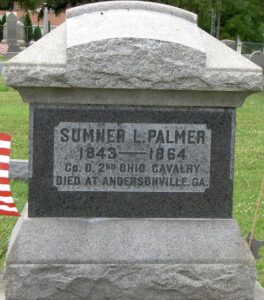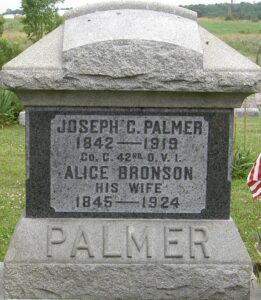Ashes to Ashland: Sumner Palmer, A Lost Civil War Veteran
Sumner Levi Palmer was born in Sullivan, Ohio in 1843 to Zurah and Lauretta Palmer. He was held as a prisoner of war by the Confederates at Andersonville Prison in Georgia, where he died in late August/early September of 1864. He was the middle of three children. Joseph was his elder brother by one year and Melvin was his younger brother by 6 years. We have no letters to or from Sumner in our possession, so who he is, what he believed, etc. is left lost to the annals of history. Although much about him is not known from firsthand accounts, we can piece together an idea of what might have motivated him, and use that knowledge to paint a picture of what his life may have been like.
Sullivan was known as a town of extremist beliefs by most Ashland County residents. It was a hotbed of abolitionist beliefs and according to the Ashland Union Newspaper, to support Abolition was to wish death upon the United States. We know that Joseph joined Company C of the Union Army in 1861 as a young man of around 18 years old. After arriving at Camp Chase, Company C asked collectively to join the 42nd Ohio Infantry after learning it was led by Colonel James Garfield, who raised the unit himself through travelling around and giving speeches. Garfield gave a speech at the Ashland County courthouse just a few months after Joseph joined. Garfield said in his speech, according to his letters, that Ashland is a place filled with those who are “afraid ‘to do good on the sabbath.’” It is likely that the Palmer family was Presbyterian, like most of Sullivan Township. These highly religious people were staunch abolitionists, but in many cases, may have been opposed to war and violence due to their Christian beliefs. This belief was clearly common enough that a Colonel recruiting in the area thought it to be worth using as a recruiting point. Garfield was a man who was staunchly opposed to slavery, and recruited almost solely on the basis of abolition. This character attracted Palmer and his comrades so strongly as to request him specifically.
The Palmer brothers did not join at the same time. Joseph joined early and was in the infantry. He fought for much of the war and was discharged with his unit toward the end of the war in September 1864. Sumner joined three years after his brother. Why they did not join at the same time, we do not know for certain. We know Sumner joined the 2nd Ohio Cavalry in 1864, and he is not in the draft registry for the year – meaning his late enlistment was voluntary, and not due to the four drafts conducted from 1863-65. Using this information, we can speculate on how he managed to become interned at Andersonville, where he would die. Why would he join so much later than his brother did, when they were only a year apart in age? The reason Sumner joined is purely up to imagination and some historic context to create potential answers. But overall, we cannot truly know why, but we do know that his decision to join would cost him his life.
Sumner joined in February of 1864 and would only be in the army for 6 months, but it was during some of the heaviest fighting of the war. The 2nd Cavalry fought alongside the Army of the Potomac during Grant’s Overland Campaign into the South in 1864. The timeline of Sumner’s enlistment means that the first major battle he could have fought in would have been The Battle of the Wilderness. There are only a few battles in which he could have fought. He could have fought in The Battle of Spotsylvania Courthouse, Totopotomoy Creek, and/or Sherridan’s Shenendoah Valley campaign. The specific battle he was likely captured during was The First Battle of Reams Station. This battle took place on June 29th during the so-called “Siege of Petersburg”. It was not a major battle, but there were 600 casualties or captives, some of which were members of the 2nd Ohio, and all of whom are documented as having been interned at Andersonville Prison. This newly constructed prison n the Deep South is known for its poor living conditions and high death rates.
Andersonville would be Sumners last destination. We do not know when he arrived, but we do know that his stay there was not long. From the evidence we have from those who survived Andersonville, we know that the prisoners were packed like sardines and disease was rampant. In addition, much of the supplies that were intended for prisoner use were withheld from them, leading to starvation and an increase in diseases from poor sleeping and living conditions. It is likely he arrived at Andersonville in July, shortly after the First Battle of Ream’s Station. He is reported as having died on September 16, 1864, by the roster which states his enlistment date as February 24th of the same year.
We do not know how Sumner died. He is not on the records of the medical clerk or in the burial records of Andersonville, GA. Sumner lived a short and tragic life, but it is not one that is unique to him. Sumner is but one of many soldiers who fought for the Union in the Civil War who are not remembered today. The reasons they fought are forgotten, but that does not mean they are forgotten. Joseph Palmer was mustered out with his Company on September 30, 1864, just mere days after Sumner died. It is unlikely that he knew about his brother’s death. Joseph fought for years, likely in fear for his life hundreds of times, but he made it to the end. How many brothers in arms he lost, we cannot know. What relief he must have felt in surviving the war, or what guilt he may have felt for outliving his comrades, is only known to him and history. Did Joseph think his brother was more likely to make it out than he was? Was he nervous that his brother was involved in the main front of the war, where it was more dangerous? The mind of Joseph was likely consumed by inner turmoil.
Joseph’s brother Melvin died in 1884 at the age of 35. Joseph died in 1919, and is buried with his wife Alice, beside his parents and near Melvin. The whole family now rests together save one. Sumner’s final place of rest is unknown. He may be buried in an unmarked grave in Andersonville, or he may have died in combat without his body being recovered, and only assumed to have gone to Andersonville with his comrades. Interestingly, in the Andersonville records, there is a F.G. Palmer from Sumners unit listed among those deceased around the time of Sumner’s death. Was it a clerical error? Or another person entirely? Although we cannot know where his body rests, we do know he has not been forgotten. Sumner’s year of birth and death are engraved on the back of Joseph’s headstone in the Southview Cemetery in Sullivan.


